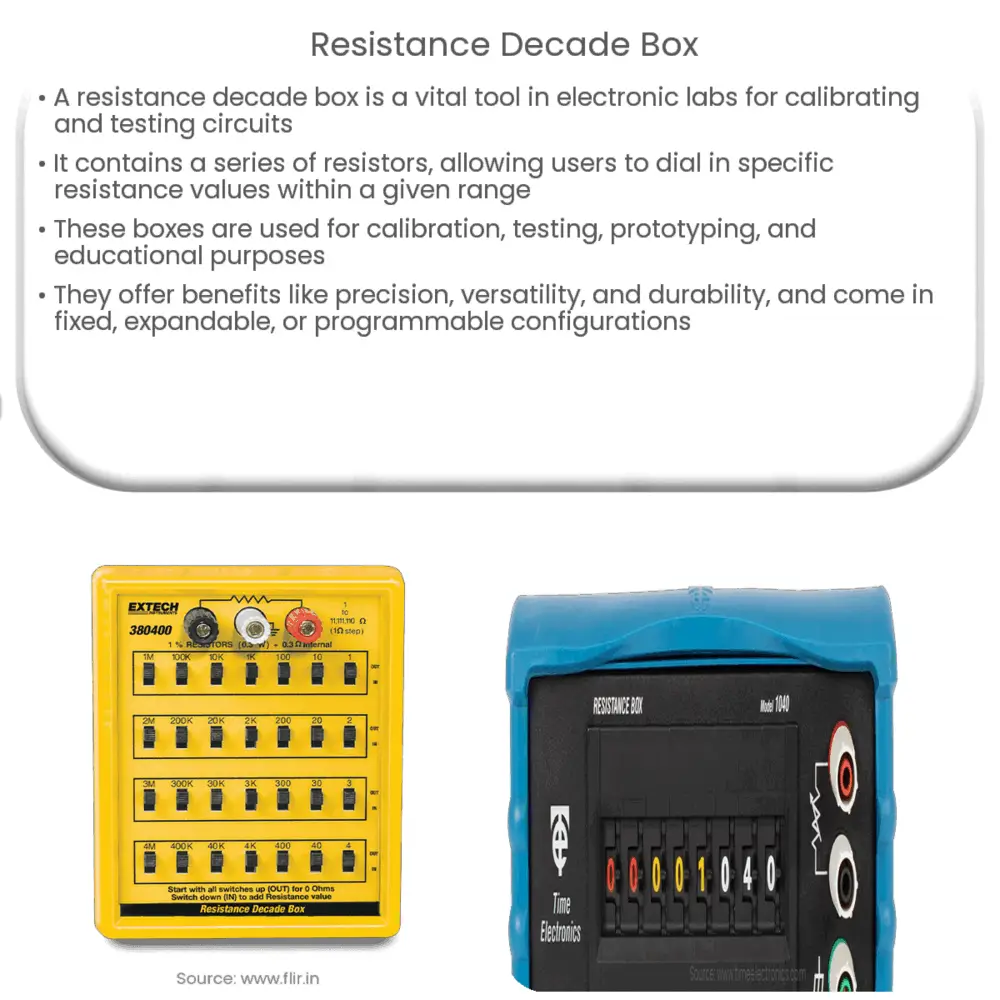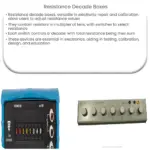A resistance decade box is a versatile electronic tool used to dial in precise resistance values for calibrating, testing, and troubleshooting electrical circuits.

Understanding the Resistance Decade Box
A resistance decade box is a versatile and invaluable instrument used in electronic laboratories and workshops for calibrating, testing, and troubleshooting electrical circuits. It comprises a series of resistors arranged in such a way that the user can easily dial in any desired resistance value within a specified range. This article delves into the workings, applications, and advantages of a resistance decade box.
How Does a Resistance Decade Box Work?
A typical resistance decade box consists of multiple rotary switches, each connected to a set of resistors. The resistors are organized in a ladder-like configuration, with each switch corresponding to a specific decade of resistance. The term “decade” refers to a factor of ten, and each switch offers a tenfold increase in resistance values. The lowest switch might cover the range of 1 to 10 ohms, the next one 10 to 100 ohms, and so on.
By rotating the switches, the user can select and combine various resistance values, creating a custom resistance value within the device’s range. For instance, if the user needs a resistance of 745 ohms, they would set the first switch to 700 ohms, the second switch to 40 ohms, and the third switch to 5 ohms. The total resistance will be the sum of the selected values (700 + 40 + 5 = 745 ohms).
Applications of Resistance Decade Boxes
Resistance decade boxes have a wide range of applications in electronics, primarily focusing on calibration, testing, and troubleshooting. Some of the most common uses include:
- Calibration of measuring instruments: A resistance decade box can provide precise resistance values, which are essential for calibrating measuring instruments such as multimeters and ohmmeters.
- Testing and troubleshooting circuits: Engineers and technicians can use resistance decade boxes to simulate various resistance values in a circuit, allowing them to test components, identify faults, and determine the optimal resistance for a specific application.
- Prototyping: During the design and prototyping stage, a resistance decade box can be a useful tool for determining the best resistance values for a circuit before committing to purchasing or soldering specific resistors.
- Teaching and learning: Resistance decade boxes are valuable educational tools, helping students understand the concept of resistance, Ohm’s Law, and the behavior of electrical circuits in response to varying resistance values.
Advantages of Resistance Decade Boxes
Several key benefits make resistance decade boxes an essential tool in any electronics laboratory or workshop:
- Precision: High-quality resistance decade boxes offer excellent precision and accuracy, with some models providing a tolerance as low as 0.1%.
- Versatility: With a wide range of selectable resistance values, decade boxes can be used in various applications and scenarios.
- Convenience: The ability to quickly dial in specific resistance values without the need for separate resistors simplifies testing and troubleshooting processes.
- Durability: Most resistance decade boxes are built with robust materials, ensuring a long lifespan and reliable performance in various environments.
Types of Resistance Decade Boxes
Resistance decade boxes come in various configurations and sizes, each with its unique features and capabilities. Some of the most common types include:
- Fixed Decade Boxes: These boxes feature a set number of switches and a predetermined range of resistance values. Fixed decade boxes are more affordable and compact but offer limited flexibility in terms of resistance options.
- Expandable Decade Boxes: These boxes allow users to add or remove decades of resistance, offering greater versatility and customization. However, expandable decade boxes tend to be bulkier and more expensive compared to their fixed counterparts.
- Programmable Decade Boxes: These boxes incorporate digital controls, enabling users to input resistance values via a keypad or computer interface. Programmable decade boxes offer a high degree of accuracy and automation but are more complex and expensive than other types.
Selecting the Right Resistance Decade Box
When choosing a resistance decade box, consider the following factors to ensure it meets your needs:
- Resistance Range: Determine the minimum and maximum resistance values required for your applications and select a decade box that covers the entire range.
- Accuracy: Choose a decade box with an accuracy level that suits your specific tasks. High-precision applications may require a box with a tolerance of 0.1% or better, while general-purpose tasks may only need a tolerance of 1% or 5%.
- Number of Decades: Evaluate the number of decades necessary for your work, considering whether a fixed, expandable, or programmable box is most suitable.
- Size and Portability: Depending on your workspace and storage requirements, consider the physical dimensions and portability of the resistance decade box.
- Budget: Assess your budget and weigh the cost of the decade box against its features and capabilities, keeping in mind that higher accuracy and expandability often come at a higher price.
Conclusion
A resistance decade box is an indispensable tool for electronics professionals and enthusiasts alike, offering precision, versatility, and convenience in a wide range of applications. By understanding the different types of decade boxes available and considering factors such as resistance range, accuracy, size, and budget, you can select the ideal decade box to meet your specific needs and enhance your work in electronics testing, troubleshooting, and prototyping.



